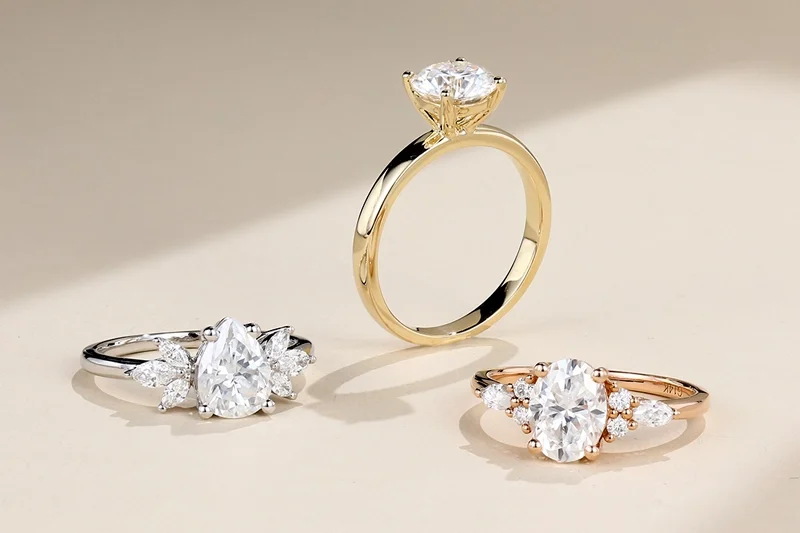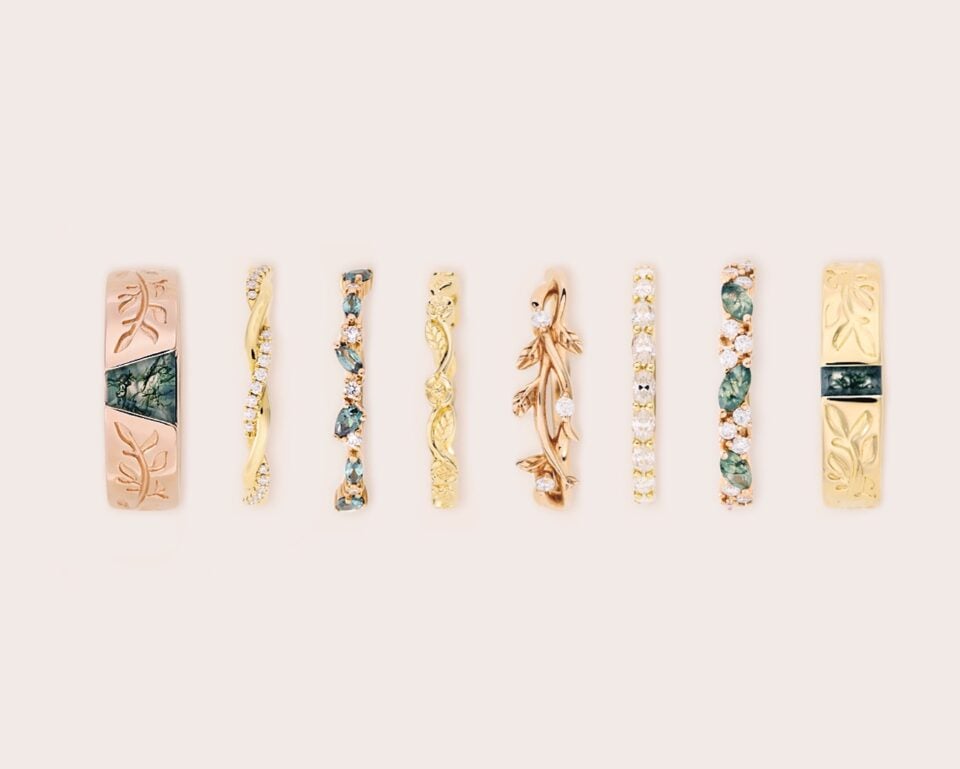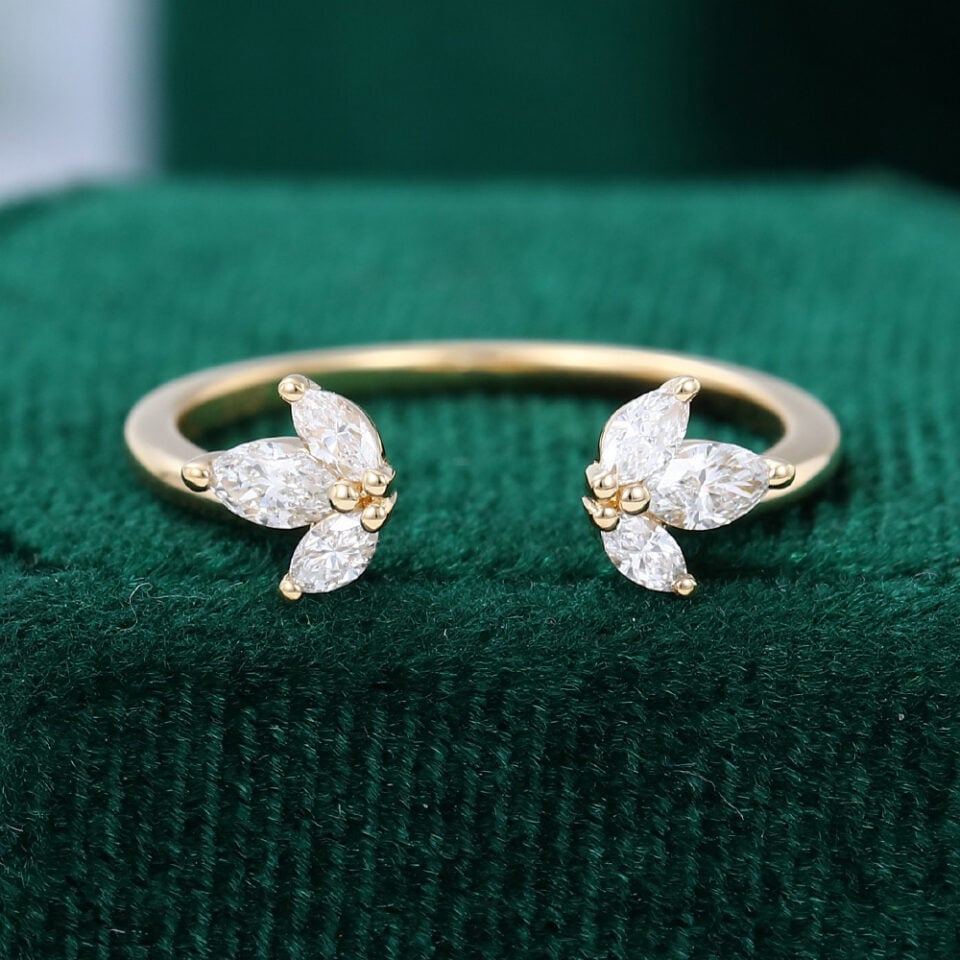- by MollyJewelryUS
- August 18, 2025
- Buying Guides
When couples start shopping for rings, one of the most common questions is: What’s the difference between an engagement ring and a wedding ring? As iconic symbols of love and marriage, these rings mark different chapters of the love story—the promise to marry and the marriage itself.
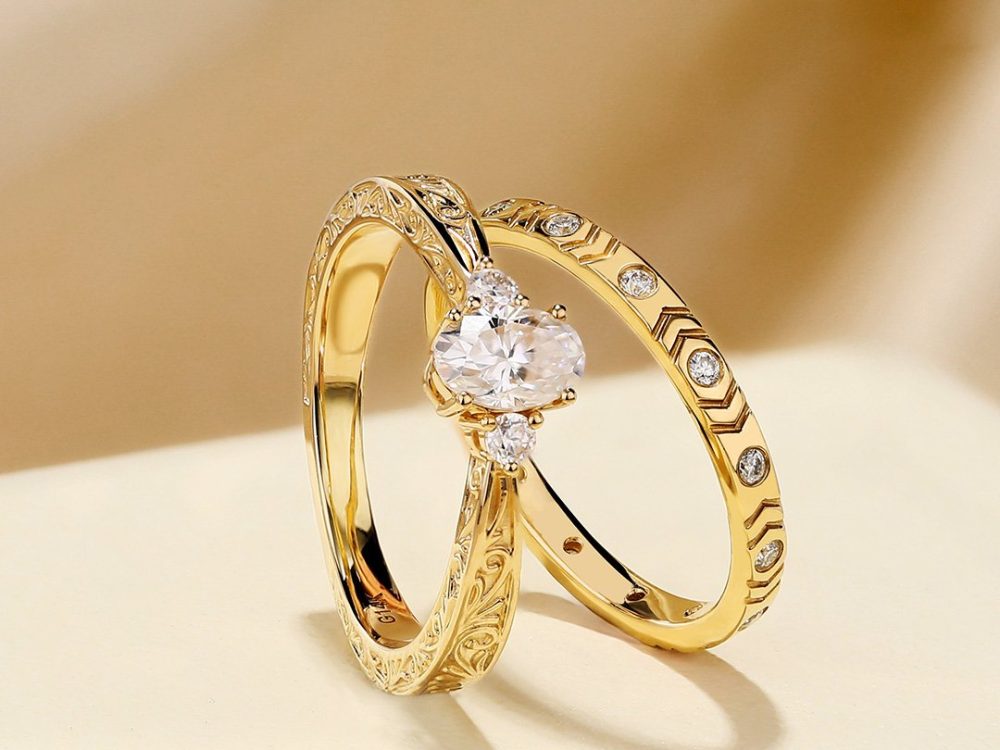
Main Differences Between Engagement Rings and Wedding Rings
Main Differences Between Engagement Rings and Wedding Rings
| Feature | Engagement Ring | Wedding Ring |
|---|---|---|
| Purpose | Given at the proposal to symbolize the promise of marriage | Exchanged at the wedding ceremony to seal the vows |
| Symbolism | Commitment, love, and the start of a shared future | Fulfillment of the promise, eternal bond, loyalty |
| When It’s Given | During the proposal | During the wedding ceremony |
| Who Gives It | Traditionally the proposer | Exchanged by both partners |
| Who Wears It | Typically the one being proposed to | Both partners |
| Wearing Period | From the proposal onward | From the wedding onward |
| Design | Usually features a prominent center stone (diamond or gemstone) | Often a simpler metal band, sometimes with small accent stones |
| Price | Generally higher, due to the center stone | Typically lower, as designs are simpler |
Engagement Ring vs. Wedding Ring: History & Meaning
Engagement Ring vs. Wedding Ring: History & Meaning
· Engagement Ring
· Engagement Ring
The idea of giving a ring to mark an engagement dates back to ancient Rome, where rings were first used as symbols of contract and commitment. Over time, gold replaced iron and copper, and the tradition evolved into a sign of wealth and devotion.
The modern engagement ring as we know it, centered on a sparkling gemstone, was shaped by two milestones: the 1477 diamond ring of Archduke Maximilian of Austria, which sparked a trend among European royalty, and the 20th-century “A diamond is forever” campaign, which firmly linked diamonds with everlasting love. Today, engagement rings symbolize the promise of marriage and are often the most expressive piece of jewelry a person will own.
· Wedding Ring
· Wedding Ring
Wedding rings, also known as a wedding bands—the two terms are often used interchangeably—is the ring exchanged by couples during the ceremony to mark their official union in marriage.
Wedding bands have an even older story, with origins tracing back to ancient Egypt. The circle was seen as a symbol of eternity, and rings were worn on the fourth finger of the left hand, believed to hold the “vein of love” that led directly to the heart.
The tradition spread through Rome and Christianity, gradually becoming part of wedding ceremonies. In modern times, especially after World War II, exchanging rings became a universal practice for couples worldwide. Unlike engagement rings, wedding bands represent the fulfillment of vows—a daily reminder of loyalty, unity, and eternal love.
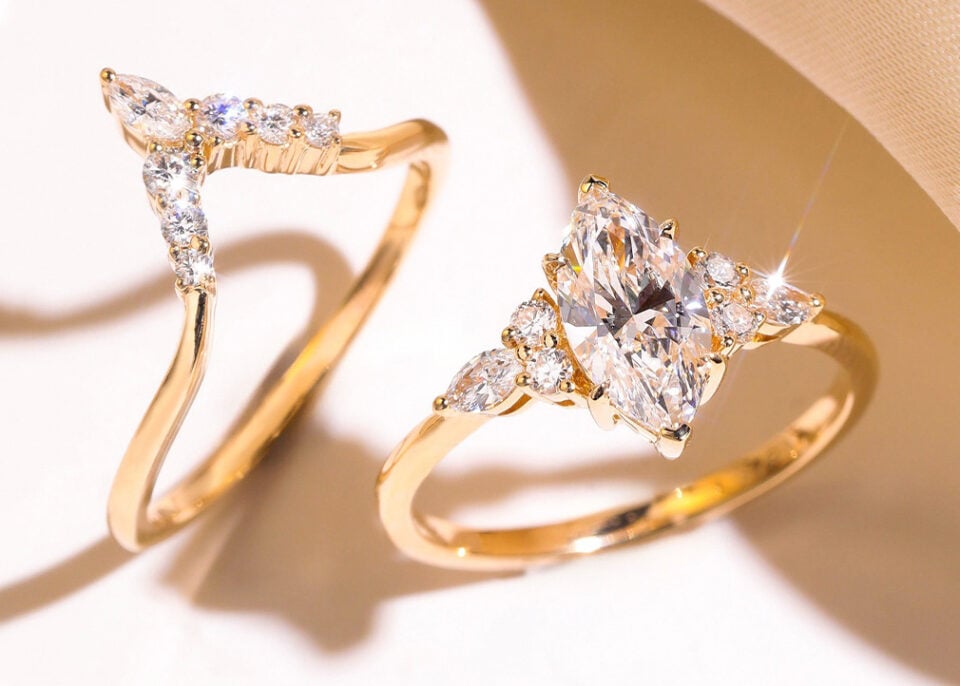
Engagement Ring vs. Wedding Ring: Design Differences
Engagement Ring vs. Wedding Ring: Design Differences
· Engagement Ring
· Engagement Ring
An engagement ring is designed to stand out. The classic look centers on a prominent stone, most often a diamond, but increasingly moissanite or other gemstones, held by prongs that elevate it above the band. More and more people like designs with accent stones, but you can always spot the more prominent primary stone at a glance. Popular styles include solitaires, halos, side-stone designs, and hidden halos—all meant to maximize sparkle and symbolize the excitement of the proposal. Because of this emphasis on the center stone, engagement rings are usually more ornate and carry a higher price point.
· Wedding Ring
· Wedding Ring
Wedding bands, on the other hand, are created for daily wear. Their design leans toward simplicity and comfort: a plain metal band, a half- or full-eternity with small accent stones, or subtle textures. The focus is on durability and ease of stacking with the engagement ring. Some people only wear their wedding rings after getting married, therefore, wedding band is more about an enduring symbol that can be worn comfortably every day.
Do You Need Both An Engagement Ring and a Wedding Ring?
Do You Need Both An Engagement Ring and a Wedding Ring?
Whether or not you need both rings depends on tradition, culture, and personal preference. In many Western cultures, it is common to have both: the engagement ring marks the promise, and the wedding ring seals the vows at the ceremony. Together, they tell a complete love story.
That said, there are no strict rules:
Engagement Ring Only: Some couples prefer to treat the engagement ring as their single, lifelong ring—especially if it already feels bold or meaningful enough on its own.
Wedding Ring Only: In other cultures, exchanging simple wedding bands at the ceremony is the only tradition, without a separate engagement ring.
Both Rings: The most common choice, especially for those who enjoy stacking styles or want a set that grows with their relationship.
💡 Tip: If you do plan to wear both, think ahead when choosing your engagement ring. A design that allows stacking (or buying a matched bridal wedding ring set) can save you time and give you more harmony between the two rings.
How to Stack Engagement Rings and Wedding Bands
How to Stack Engagement Rings and Wedding Bands
Wearing an engagement ring and wedding band together is a tradition in many cultures, but the way you stack them can completely change the look and comfort of your set. Let’s start by understanding how to wear them together and the desired look:
· Classic Order
· Classic Order
At the wedding ceremony, the wedding band is placed on the ring finger first, followed by the engagement ring on top. This is the most traditional and widely recognized way to wear these two rings.
· Seamless Flush Fit
· Seamless Flush Fit
One of the most desired looks is a flush fit, where the wedding band sits perfectly next to the engagement ring with no gap in between. This seamless look creates a clean, unified appearance on the finger. Since most people purchase the engagement ring first, wedding bands are often designed in various styles to fit around the height and overall shape of the engagement ring. Depends on the engagement ring setting, wedding bands include straight bands, curved bands, or open bands, each adapting to different engagement ring styles.
Now that we’ve explored how the two rings are traditionally worn and the kind of look couples often aim for, let’s take a closer look at the different wedding band designs, why they exist, and how they can pair beautifully with an engagement ring.
Straight Band
Straight Band
The most classic option is the straight wedding band. It can be a plain metal band or accented with small diamonds or gemstones.
Based on the number and arrangement of stones, straight bands can be divided into the following common types:
Half eternity (½ eternity): Stones cover only the top half of the band—comfortable, practical, and easier to resize.
Three-quarter eternity (¾ eternity): Stones cover most of the band but leave a small section plain at the back. This balances sparkle with wearability.
Full eternity: Stones encircle the entire band for maximum brilliance, but resizing is difficult and the design can feel less comfortable for everyday wear.
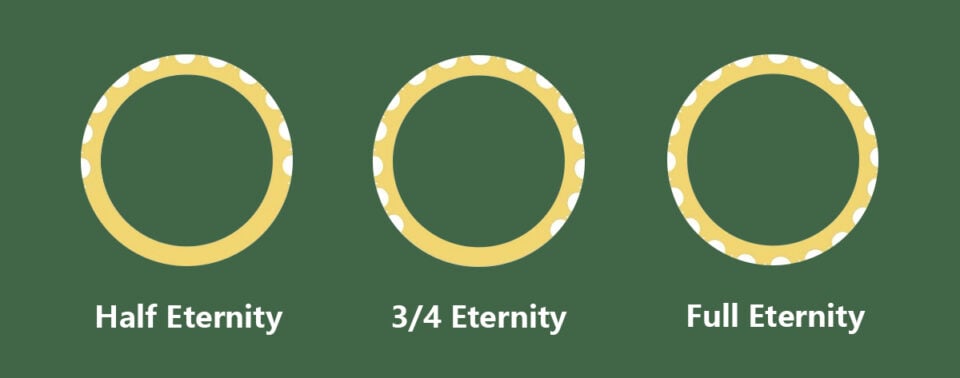
Curved Band
Curved Band
A curved (or notched) band is shaped with an arc that wraps around the engagement ring’s overall shape. This creates a harmonious look and avoids awkward gaps. Curved bands are especially popular for low-profile engagement rings that sit closer to the finger, as there will be a gap between the two rings when a low-set engagement ring is stacked with straight bands.
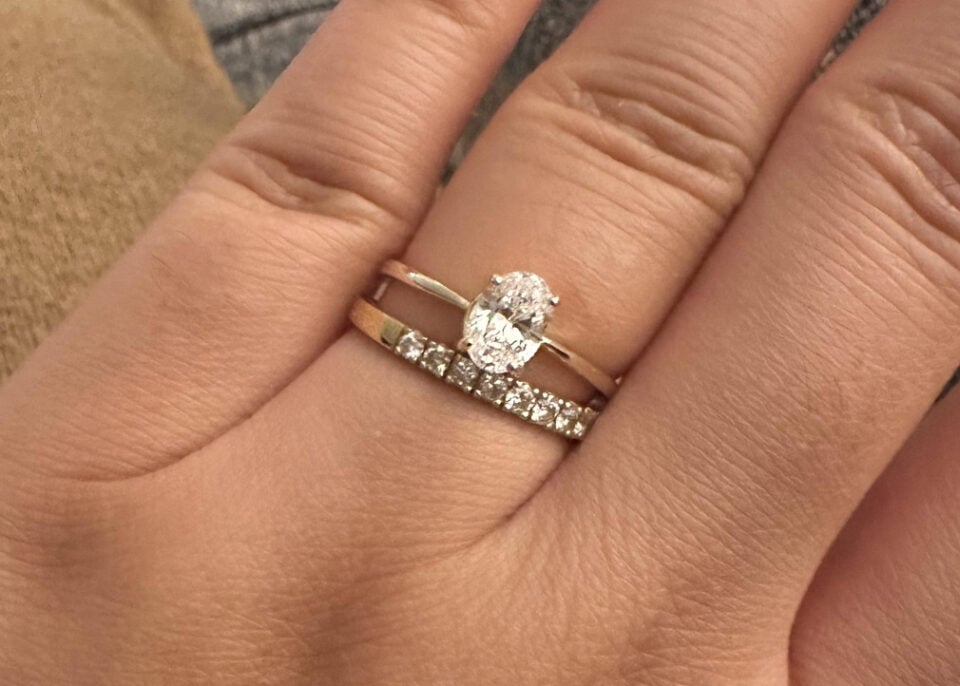
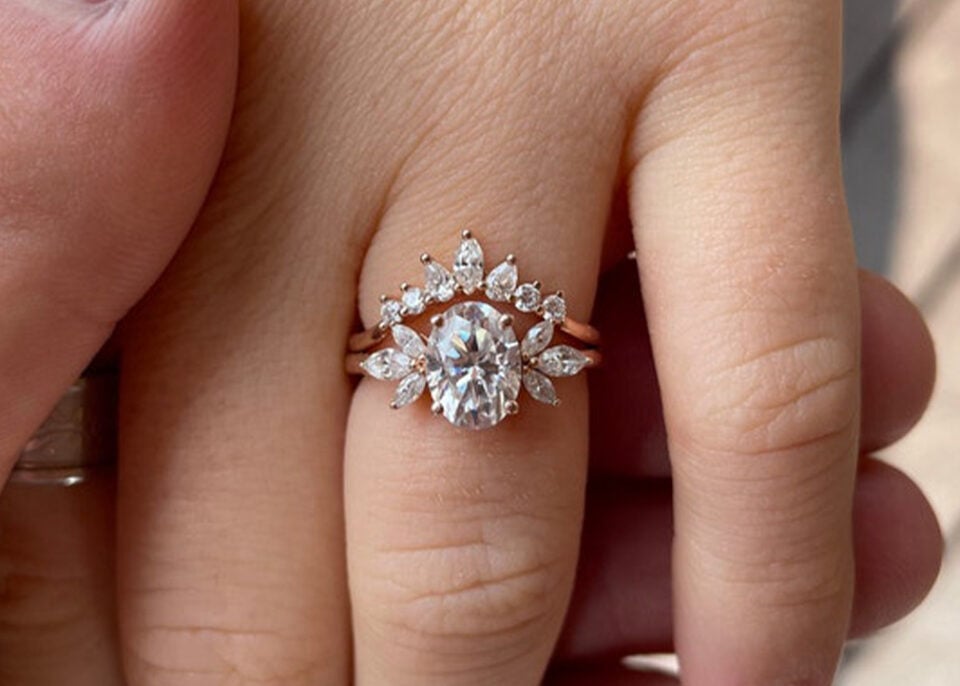
Open Band
Open Band
Similar to curved wedding bands, open bands are also designed to match the shape of engagement rings. With the space in the middle, the engagement ring’s center stone will be able to “nest” inside. This modern, airy design adapts well to unconventional engagement ring shapes and creates a unique stacked look.
Enhancer Band
Enhancer Band
For maximum impact, an enhancer band (also called a ring jacket) surrounds the engagement ring with two bands connected at the back. This not only locks the engagement ring in place but also adds dramatic sparkle, making the center stone appear larger and more prominent. Enhancer bands are perfect for those who want their wedding set to feel bold and luxurious.
Things to Consider:
For high-set engagement rings, make sure the enhancer’s space can accommodate the shank’s width and thickness comfortably.
For low-set engagement rings, you’ll need to check not only the shank but also whether the head or basket of the center stone can slide into place without obstruction.
It usually adds extra width to the finger, which can feel bulky for those who prefer a minimal style.
Enhancer bands may require a little larger ring size than usual.
FAQs About Engagement Rings and Wedding Rings
FAQs About Engagement Rings and Wedding Rings
Are engagement rings and wedding rings the same thing?
No. An engagement ring is usually given at the proposal and often features a center stone, while wedding bands are exchanged at the ceremony and are usually simpler, designed for everyday wear.
Do I have to buy both an engagement ring and a wedding ring?
Not at all. While owning both is traditional in many cultures, some couples prefer just one. The choice depends on your lifestyle, traditions, and what feels meaningful to you.
Who buys the engagement and wedding ring?
Traditionally, the proposer buys the engagement ring, and the couple buys the wedding bands together. These days, many couples plan and budget for both as a team.
Engagement ring and wedding band which goes first?
The most common way is to wear the wedding band first, with the engagement ring stacked on top. Some prefer to wear them separately, and others stack them with additional bands for a unique look. View Engagement and Wedding Ring Wearing Guide for more details.
Can an engagement ring be used as a wedding ring?
Of course. The engagement ring can also be the wedding ring (if you want). Many couples also use their engagement ring as their wedding ring.
